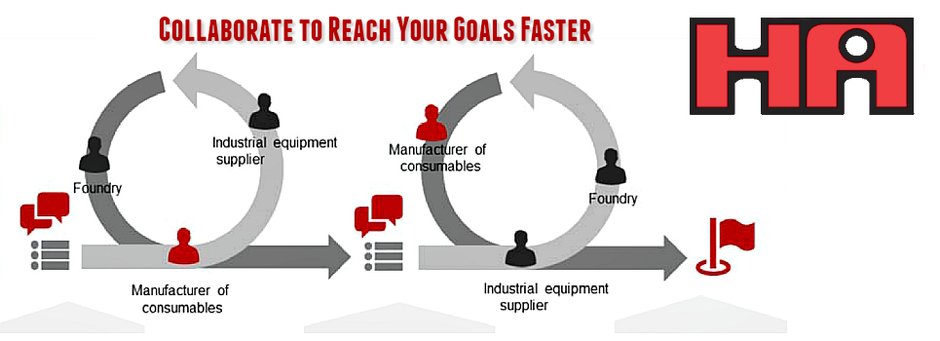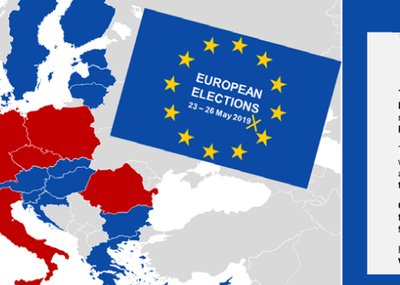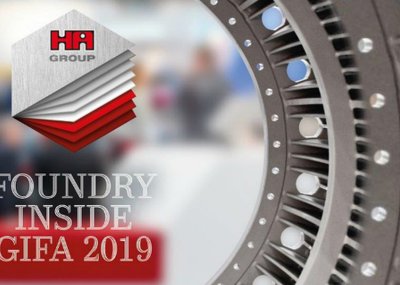New products and production techniques are the direct result of technological advances. Innovations are not only the foundation for growth, they are also a decisive factor in securing the competitiveness of companies. Right now, the foundry industry’s two largest customer segments, the automotive and mechanical engineering sectors, are under intense pressure to innovate. The following article outlines the major considerations behind a new culture of joint innovation between foundries and suppliers, as presented by Dr. Carsten Kuhlgatz, Managing Director of Hüttenes-Albertus (HA) Chemische Werke GmbH, during his key-note speech at the Großer Gießereitechnische Tagung 2018 in Salzburg.
His assertion: Open Innovation, i.e. cooperating with external partners on joint re-search and development, is an important tool in modern innovation initiatives.
In 2016, the management consultancy Staufen conducted research into the importance of innovations for modern industrial companies. For the “Industry Monitor: Innovation 2016”, Staufen surveyed 183 industrial companies in Germany on the topic of innovation. As the study results show, four out of five companies believe that innovations have become more important than ever before. However, more than 40 percent of companies are uncertain of the best way to proceed with their innovation work, especially against the backdrop of the latest technological developments. Despite this uncertainty, it is clear that there is a general atmosphere of disruption in relation to generating new ideas. As a result, more than two out of every three companies have already changed the way they develop their innovations. Or to put it the other way round: only 32 percent approach innovation work in the same way as they have in the past.
The pressure to innovate in the foundry industry
What is true for industry in general is just as true for the foundry industry: Innovation is the only way companies can secure their long-term competitiveness and not only survive, but thrive, in the global market. After all, the pressure to innovate is particularly high in the automotive and mechanical engineering industries, which just happen to be the foundry industry’s two most important customer groups. The Staufen study shows that around three quarters of companies in both the automotive industry (78 percent) and the mechanical and plant engineering industry (75 percent) currently feel under intense pressure to be innovative.
Castings make a key contribution to technological advances in these industries. As a result, customers place ever higher demands on innovative castings. In addition to in-creasing customer requirements, however, there are other factors driving the pressure to innovate in the foundry industry. (Fig. 1)

Fig. 1 In addition to growing customer requirements, there are other factors driving the pressure to innovate in the foundry industry.
What do we mean by innovation?
First of all, we need to be aware that there are different types of innovation: product innovations, process innovations, organisational innovations and business-related innovations. For the purpose of the following statements, innovation is only being referred to in terms of technical innovations, i.e. product innovations and process innovations.
- Product innovations include improvements to existing products or services on the one hand, and the development of new products to expand a company’s product portfolio on the other.
- Process innovations are improvements to manufacturing processes and work-flows. They lead to productivity and quality gains, and also help to cut costs.
Innovation begins with the generation of ideas. But where do these ideas come from?
There are a variety of systematic approaches that can support the structured development and collection of ideas. First of all, ideas can originate within a company itself, as the product of creativity techniques or ideas competitions, for example. At the same time, companies also need to look outwards. As well as keeping a close eye on market developments and bench-marking themselves against their competitors, companies can also involve customers and/or business partners to generate ideas and innovations. (Fig. 2)

Fig 2: Methods and sources for generating ideas
Opening the innovation process to the outside world
This collaborative approach to innovation, or opening the innovation process to the outside world, is commonly referred to as “open innovation”. In every company’s surroundings, there is a huge potential of ideas, technologies and competences just waiting to be exploited. Through strategic collaboration with appropriate external partners, companies can significantly increase their innovative power, quality and speed.
In the past, innovations used to be developed in secret in the lab by the company’s researchers. Today, companies involve external partners in a targeted manner. By opening their innovation processes to their customers and suppliers as well as to start-ups and research institutes, they are able to gain faster access to user requirements, expert knowhow and new technologies.
According to the Staufen study, this has already been recognised by many industrial companies. A good two thirds of companies say that they work more closely with external partners to develop innovations than in the past. (Fig. 3)

Fig. 3 Has cooperation with partners changed in the past two years? Will they be more inten-sively involved in innovations? (Source: Staufen study)
The following quote, which originally appeared in a study published by the Fraunhofer Institute for Industrial Engineering IAO, aptly describes the necessity for open innovation processes, stating:
“It is a company’s network-building ability that will determine their economic success or failure in the future. The complexity of products and processes is increasing to such an extent that it can only be mastered through cooperative divisions of labour, i.e. collaboratively”.
Foundry industry: innovation through cooperation
So, let’s examine the current situation in the foundry industry. Foundries operate in a highly complex field of technology characterised by complex process chains and a variety of individual factors exerting mutual influence on each other. Even a small change to one parameter may have a major impact on the remaining steps in a process and ultimately to the quality of the final product. In-depth expertise in the fields of mechanical engineering, metallurgy, foundry chemistry and process technology is indispensable in order to ensure optimal foundry processes and products. At the same time, however, the number of highly qualified specialists, such as foundry and process engineers, is constantly in decline. Against this background, it becomes clear that it is virtually impossible for a single foundry or supplier to achieve major technological advancements. Collaboration with strategic partners is the only path to success.
One of the most promising approaches to collaboration is project-based cooperation – provided it is done correctly. In the past, the foundry normally started by creating a new plant line design in cooperation with the machine manufacturer. Only after completion of the equipment did the foundry turn to the suppliers of consumables to select the appropriate products for the production of its castings. This sequential approach is not only very time-consuming, but often also leads to less than optimal results, because the predetermined plant design is restricted to a specific process. (Fig. 4)

Fig. 4 Joint development: simultaneous instead of sequential
However, early collaboration between foundries, industrial equipment manufacturers, consumables suppliers and, if necessary, universities and other institutes in a simultaneous approach makes it possible to shorten the time required for product and process innovations. Involving all parties right from the start, and working simultaneously on different aspects of a solution, leads to faster and better results. (Fig. 5)

Fig. 5 Complementing each other with their expertise: foundries, industrial equipment suppliers, manufacturers of consumables
Case study: Establishing inorganic core production in China
So much for the theory. Let’s now turn to a current, real world example from the HA Group: Due to drastic new environmental regulations, a large Chinese automotive foundry was forced to completely convert its core production from organic to inorganic within just one year. In this short time, a production line with 36 core shooters had to be installed and commissioned. The customer for this flagship project, Kolbenschmidt Pierburg Shanghai Nonferrous Components (KPSNC), is the largest manufacturer of cylinder heads in China. Right from the start, the Chinese foundry company brought in renowned partners for toolmaking, mechanical engineering and foundry chemistry. The companies Aurrenak and Meissner helped to optimise the tools, Laempe and Loramendi supplied the core shooting machines and carried out core shooting tests, Hüttenes-Albertus provided support with laboratory tests, the selection of the binder system and core shooting simulations.In developing solutions, experts from these technology suppliers regularly cooperated in Europe and at the Chinese foundry, which meant that the production processes could be developed and installed in close coordination both with each other and with the customer. The first inorganic-bonded cores were shot as early as mid-2017. Thus, the partners achieved what they had previously thought hardly possible: The project, unique in its type and size, made rapid progress thanks to the excellent cooperation of the various partners and was actually completed very successfully within the allotted time. By the end of 2017, fully automatic core production was in full swing – as planned – and 2,000 cylinder heads were being shot per day. KPSNC is proud to report that, by mid-2018, it had already produced more than one million castings for large automobile manufacturers (OEMs) using inorganic cores. (Figs. 6 and 7)

Fig. 6 Inorganic core production at KPSNC in Kunshan, China.

Fig. 7 An inorganic water jacket core.
The right place for joint development projects
For HA, the successful project described above is by no means a one-off. The underlying concept is an integral part of HA’s corporate culture. In order to develop and launch new products and solutions in a faster and more targeted way, HA created a new cooperation platform at the end of 2017: the HA Center of Competence. This is the perfect platform for cooperative partnerships with foundries and machine manufacturers, toolmakers and research institutes (Fig. 8).

Fig. 8 HA Center of Competence: the right place for joint development projects
In addition, it enables extensive testing of new developments from the laboratory before they are used. Working in parallel on different aspects of innovation development, and closely integrating development steps and findings, allows the partners reach their goals faster and more successfully. The agile working method is characterised by a high degree of transparency and flexibility. As is seen time and again, true collaboration delivers results faster than traditional project methods: partnership is the most effective path to successful product and process innovations.
Dr. Carsten Kuhlgatz, Hüttenes-Albertus Chemische Werke GmbH, Hannover





